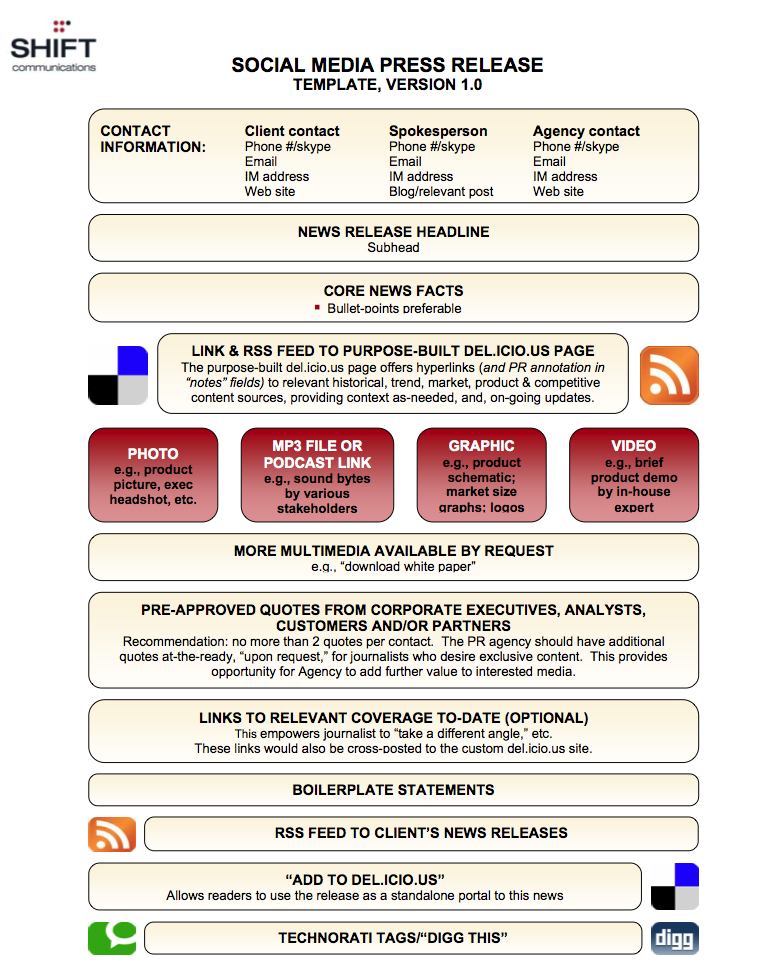
Silicon Valley journalist/blogger Tom Foremski had had enough. Two years ago, he wrote a poison pen letter to the PR industry in a blog post titled Die! Press release! Die! Die! Die!, in which he exhorted publicists to break down press releases into sections, tag the information and provide links to more sources.
“Press releases are nearly useless,” he wrote. “They typically start with a tremendous amount of top-spin, they contain pat-on-the-back phrases and meaningless quotes…Press releases are created by committees, edited by lawyers, and then sent out at great expense through Business Wire or PRnewswire to reach the digital and physical trash bins of tens of thousands of journalists. This madness has to end. It is wasted time and effort by hundreds of thousands of professionals.”
Much to Foremski’s great surprise, PR pros actually listened. A few months later, Todd Defren at SHIFT Commmunications released the Social Media Press Release (click the image at left to see it). That soon crossed the pond, where UK publicists at Webitpr created their own riff called the Social Media News Release (SMNR). In both cases, the press releases were more than just long-form text. Instead they feature:
> Contact information prominently displayed up top.
> A list of basic facts.
> A series of quotes.
> Company logos and photo headshots.
> Related audio or video.
> Social bookmarking or sharing links to sites such as Digg and del.icio.us.
> RSS feeds.
> Comments.
As press releases start to include more social-media elements, they are also popping up in search results and news aggregators such as Google News and Techmeme, letting companies take their messages directly to consumers, investors and anyone else interested in their products. That means the people who craft press releases must think about new audiences and ways they can turn up higher in search results by using search engine optimization (SEO) techniques.

Despite all the talk about SMNRs, they still have a long way to go for mainstream acceptance in the PR industry. Foremski told me he was glad that PR folks were paying attention and trying to make changes, but that he hadn’t seen too many of these new-fangled SMNRs.
“All I wanted was to put some links in it and some tags,” he said. “When I wrote the piece I was amazed at the storm it created. I was just saying to take the media technology that we have and apply it to this type of information. And they’re still arguing about it. I don’t know what the problem is, because if you do break it up, you can have both: your traditional release and other formats. Has it made much of a difference? Not yet. I see one or two of them occasionally.”
Going Around Gatekeepers?
Foremski is especially worried that press releases now rank highly on search engine results or in aggregators such as Google News, and hopes that readers don’t confuse company releases with real news stories.
One of the sparks for this story was a recent email I received from a publicist for Business Wire, a wire service for press releases, who noted the newfound power of company press releases:
Business Wire has morphed into what can be called a high-speed ‘search engine news delivery service’ with newfound capabilities to aggressively shoot to the top of search engines, news sites and social media with clientele’s materials. When press releases can be coded and stuffed with multimedia to the point that they receive more traffic and linkage than the same news stories which add the nuance and interpretation, who is doing an end run around whom?
The example Business Wire gives was the recent story of AOL buying Bebo, with the Business Wire story taking top billing on the Techmeme aggregation of stories on the subject. Laura Sturaitis, senior vice president of media services & product strategy for Business Wire, told me she was spending a lot of time educating clients on new ways of optimizing press releases for search engines.

“We’re writing for reporters and writing for robots, and our clients really have to do both,” she said. “We’re in a three-year process of teaching our clients that at the time they start a press release [to consider] what they can do that’s great for a reporter, to pitch the story, but also recognize that the release is crossing out onto the Internet onto aggregators… If we have a logo or image or photograph, that shows up as a thumbnail on Google News. And we found that two and a half times more people will click on it if there’s an image than if not. People scan it and are drawn to photos.”
While Google News does include Business Wire and other PR release wires as sources, the aggregator does not highlight press releases as much as news stories, according to Josh Cohen, business product manager of Google News. Cohen told me there are a number of myths that publishers believe will help their ranking on Google News (which were debunked on the Google News blog last week).
“We won’t crawl press releases directly from a company’s website,” he said. “We crawl from the PR distributors…And we label them as press releases for our users. We treat them differently within our results, so that press releases won’t lead a cluster, they won’t be on a home page or on section pages, but if you do a search on a given story, it will show up in results.”

Cohen said that photos on Google News can help draw clicks but it depends on the photo and the particular story. For instance, a photo of Ben Bernanke testifying before Congress might not get the clicks that a photo of a volcano erupting would get.
Gabe Rivera, who runs Techmeme, isn’t worried that people will confuse a Business Wire press release with a more analytical story from a blogger or journalist — though “editorial stories” sometimes simply parrot press releases. Rivera said that his algorithm for Techmeme doesn’t treat press releases any different than other sources, though he said that might change in the future. Rivera noted that official company blogs are another way that publicists can get their messages out to other bloggers.
“Company blogs in many ways function like press releases, and play a role similar to press releases on Techmeme,” he told me via email. “I don’t expect too many company blogs to become influential sources, but the better ones tend to receive a fair amount of attention when news breaks.”

On a recent Techmeme Leaderboard list, which tracks the most frequently cited sources on Techmeme, the Official Google Blog came in at #30, Microsoft’s press site was #33, and Business Wire was #56. The reality is that if a company’s press release or blog has breaking news, that’s where journalists and bloggers will link at the outset. But that doesn’t mean that journalists don’t have a place in the ecosystem of sources.
“I don’t see press releases ever being able compete on the same playing field as news sources and blogs on trust among educated readers because people will be able to see them as what they are — often static distributions from corporations,” said Steve Rubel, PR blogger and senior vice president, director of insights at Edelman Digital. “However, they can have a big influence through search results. In addition, they are increasingly becoming recognized as the starting point of the news cycle — something they always have been, but there’s more transparency in the entire PR process. Press releases will decline over time, I believe, in favor of other corporate sponsored media.”
What Works and What Doesn’t
The social media news release looks impressive and tech-savvy (check out this one about a Second Life project), but does it work? Ben Ayers, a senior publicist for ITV in the UK, has been using Webitpr’s SMNR and said he’s had mixed results so far.
“Anecdotally, there are mixed views from journalists, ranging from ‘Ooh aren’t you high tech’ to ‘I prefer a good old press release,’” Ayers said via email. “Overall, the response has been fairly muted. The release has definitely resulted in more online coverage, which was the aim. It has also given us a certain amount of kudos internally and externally for embracing new ways of distributing information, which again is a good thing.”
Ayers said one problem was that publicists and journalists are not using social media tools enough for the nouveau press releases to make a big difference. He would also like to see more customizable SMNRs, so he can pick specific social media functionality depending on the client.

Stephen Davies, who writes PRBlogger.com and is social media manager for Webitpr, said that one triumph for the SMNR is trackability. You can easily find out how well you’re doing with all the bookmarking, links, and multimedia you add to your release.
“We’ve been pleasantly surprised at how open-minded companies have been about the comment facility as we initially thought there would be a reluctance to venture into the unknown,” Davies said. “Obviously this is new to them and allowing anyone the ability to comment on their news material might seem quite daunting. So far we’ve only distributed one SMNR without comments so I’m very optimistic about creating two-way dialogue through news releases.”
Edelman PR, which has pushed SMNRs through its StoryCrafter press release engine, shows what can go wrong with comments on press releases. The top SMNR on its site, about a recently hired senior vice president, includes two comments — both of which are spam.

Andy Beal, a marketing consultant who writes the Marketing Pilgrim blog and co-wrote the book, “Radically Transparent” (with Dr. Judy Strauss), says that SMNRs are hit-and-miss so far.
“Things that have gone over well are simple things like having the contact information more prominent — or linking to the media room or the headshot of the individual, or stock images for a product launch,” Beal said. “But some things go too far. Embedding podcasts or video is not necessarily a must-have at this stage. The same with ‘Digg this’ buttons. If you have something that’s worthy of the front page of Digg it’s very unlikely you’ll be putting it out in the format of a press release. Some of the social media items are a bit optimistic.”
Perhaps at this early stage — just two years into the life of the SMNR vs. 100 years of the text press release — we can only expect small victories for the evolution of the format: a link here, a photo there, a little less spin. More importantly, the mindset of publicists and companies is starting to change as they realize that they are losing control of their tightly scripted message.
“A lot of companies have this delusion that they are still in control of the message,” Beal said. “But their customers have been influencing their reputation, and companies are starting to wake up to the fact that these conversations are happening online. The conversations will happen whether they participate or not, so the companies will realize that they’re better off finding their role in the conversation and joining in.”
Rubel believes that press releases will eventually be surpassed by company blogs, and by smart marketers who can become “digital curators” for their area of expertise.
“The Internet allows every company to become a media company,” he said. “It takes resources, dedication and a nose for creating good content that people want. Brands will become digital curators in high interest niches. This will either be a solo effort, or more likely, in partnership with bloggers, media companies and/or everyday consumers.”
More Resources
If you want to read more about the history and evolution of the press release, follow these links:
A Press Release for Social Media? I Think Not. at Blog Business Summit
Battle Royale about the Social Media Release at PRSquared
IABC assumes Social Media Release leadership role from IABC
Is the Social Media Press Release a Meatball Sundae? at Search Engine Watch
Press Releases Get ‘Social.’ Um, no. by Dan Blank
Social Media Releases — A Report from the Field by Brian Solis
The Definitive Guide to Social Media Releases at PR 2.0
The History, Evolution and Future of the Press Release at Tech PR Gems
The 100th Birthday of the Press Release at Search Engine Watch
What do you think about the evolution of press releases? Do you think they should be treated as equal sources in news aggregators? If you’re in PR, do you use the SMNR and have they been successful? Share your thoughts in the comments below.
Photos of Tom Foremski and Gabe Rivera by Scott Beale via Flickr.
UPDATE: There’s been a lot of great discussions out in the blogosphere sparked by this story. Folks are making an important point: Social news releases are only as good as the product or service or story you tell. A new format will not help out a flawed product.
Duncan Riley says SMNRs themselves are flawed because they don’t have enough of a hook for journalists. Mathew Ingram believes the most important part of the press release isn’t “social media” buzzwords, but links. That’s also been the concern of Foremski as well, who demanded more links in press releases.
I also heard from Maggie Fox, CEO of Social Media Group, who have been creating custom SMPRs for all Ford Motor Company releases. These definitely take the concept a step further, as the SMPRs are updated almost like a blog, with updates, photos, videos, etc. and even a blogroll at the bottom. I asked Fox what worked and what didn’t with their SMPRs. Here’s what she told me via email:
Hundreds of bloggers and [mainstream media] outlets have picked up images, video and stories from the Ford SMPRs. The fact that the SMPRs are RSS-enabled also means that they are automatically notified of updates to topics they find of interest. We can measure the number of people who have accessed our content on these platforms. What kind of content gets viewed/shared most often? This informs future content strategies (it’s like an ongoing, never ending focus group).
Stuff that hasn’t worked so well: SMPRs that support static stories. The whole idea is to create a platform that allows the story to evolve over time; when the story is dead after the SMPR is published, understandably the spread and reach of the content (and the story itself) dies rather quickly. Our platform is ideally suited to stories that evolve over time, and the individual SMPRs are updated modularly. You still have to do traditional outreach to let people know that the content is there, working it into your more traditional materials.


Mark, this is a great post. I’ll need to read it over more-than-once, and follow the links, but just wanted to thank you for this thorough look.
Great article Mark. The press release has come a long way, but PR professionals need to realize that just because some new social media site is trendy, doesn’t mean it will help carry their press release further.
Nice post. While I have many misgivings about placing PR next to ‘real news,’ this is somewhat ameliorated by the difficulty of defining ‘real news.’ When it comes right down to it, I much prefer PR, labeled as such, presented as news, than un-sourced pre-packaged fake news, or other unattributed information presented as news
Nice overview of the issue, Mark. I haven’t used an SMNR yet, but for our industry’s annual trade show we did use some of the SMNR’s elements in an online newsroom dedicated to the show. It seems to have been well-received. As for the SMNR, I don’t think it makes sense for all media. It works for some, and shows that in this day and age, it’s more important than ever for PR professionals to tailor their message and their message delivery to meet the needs of specific types of media outlets.
As Todd knows, I am not a big believer in the SMNR or SMPR or whatever you want to call it. Too many basic questions have never been asked, no real case studies showing the value (or lack thereof) of the SMNR, and my view that it ignores the basic problem: press releases with no news value, and press releases that are just poorly written.
For me, smart outreach and conversations can do what the SMNR and more effectively. While there are discussions that this does not replace outreach, there is a belief that this is an end-all, be-all while it is just a tool.
If press releases were worthless, they would not be used as sources of information by the press. If bloggers wanted to be dictated tags or stories, they would subscribe to such a service.
That said, blogs replacing press releases seems like a fantasy being sold by a flim-flam man.
A relevant article about the changing dynamics of communications. I’ve already forwarded on to a few folks still using more traditional press release formats. Thanks :)
The funny thing is, that if you de-construct the elements of a social media news release and customize their use as appropriate to the story/pitch, it can be very successful.
As an early advocate for testing the SMNR and now more of a pragmatist, the jury is still out as to whether such a format is preferred by journalists or not. Many times, such a press release format is more effective as part of a SEO strategy than a media relations effort.
In my experience, for classic PR person (who do not understand social media) it is very good, for the begining, to see a lot of coverage on the SE results for his/her release.
On the other hand, day-to-day classic PR agency activities are not very inspiring environment for advancing the knowledge of New PR.
I have a couple questions for journalists who have actually received SMNR/SMPRs: Were they inherently better quality than traditional press releases? Did they transform the way things are done in the newsroom?
When you start adding links and comments to press releases, I stop seeing the difference between a press release and a page of a corporate website…my point being, why add yet another piece of jargon to the world (SMNR) versus just calling a web page a web page? With the amount of jargon we create in this field you would think someone was getting paid to create new terms! Sorry to be cranky but that’s my honest take on this one.
Great post. I have just completed a presentation on SMNRs for my New Media class – I wish we were due to present next week so that I could have used your post as another point of view.
While I agree that adding links to other relevant articles and pictures can definitely help increase coverage (especially if the release is circulated electronically) by giving journalists more information to work with, I think Shift’s template for a SMNR is too much of a drastic change from the traditional news release format. Podcast and video links may only contribute meaningful information in a select few instances, and the del.ico.us/Digg links just clutter up the piece. Also, as you mentioned, this new format is not a substitute for good writing about newsworthy topics, all it should do is make it easier for a journalist to do their job.
The other interesting point you make is about how press releases are ranking higher on search engine results and circumventing traditional media outlets. As long as it is labeled as a press release, I personally would prefer to get information directly from the company and then read third party commentary regarding the release, as opposed to reading a published story that was just a reworked press release presented as news. With this in mind, a PR professional should definitely keep in mind that he/she is writing for multiple audiences.
Silicon valley is one of the biggest It professinal working..For intance software engineering…Blogging with links to me is good indeed because i used to do that..
________
Miles
Social Bookmarking